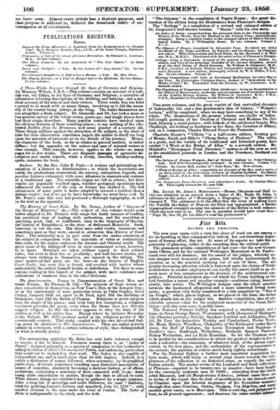flu kts.
DOING41 AND PROXECTS.
The new year opens with a very fair share of work cat out among us for its handling in that comparatively retired, but not. tranzitory depart- ment of human effort, fine art. At some of its aspects we take the op- portunity of glancing, rather in the recording than the critical spirit. The prominent artistic competitions of last year—for the new Govern- ment Offices, and for the national Wellington Monument in St. Paul's— stand over still for decision; for the award of the judges, whereby cer- tain designs were honoured with prizes, left wholly undetermined the question as to the practical carrying out of any of them. The still greatly-increasing attention which is bestowed upon the claims of Gothic architecture to secular employment can hardly but assert itself as an ele- ment more or less conspicuous in the decision of the architectural com- petition. Pictorial decoration also—of which the Union building at Ox- ford furnishes a recent and peculiar example—continues rising, however slowly, into notice. The Wellington designs raise the whole question between the hackneyed allegorical and a more historical living treat- ment; & question very fairly considered in a late pamphlet by " One of the People," which places highest, as we placed. at the time' the design which-stands-lest en the judges' list. Another competition, also of con- siderable interest—that for the sculptural memorial of the Great-Exhi- bition—will also soon come to public issue. The National Portrait Gallery has acquired a starting-point and a home in Great George Street, Westminster, with likenesses 61—Shakspere, (the Mendes portrait,) Raleigh, Speakers Lathan and Addington, Han- del, Dr. Parr, the dramatists Murphy and Cumberland,. Horne Tooke, Dr. Mead, Harley, Wyndham, Chancellor of the Exchequer under Queen Anne, the Reel of Cadogan, the Lords Torrington and Stanhope of Kneller's time, Huskisson, Wilberforce, Stothard, Spencer Perceval, Bishop Warburton, and La Belle Hamilton. Se far the Trustees seem to be guided by the considerations to which the greatest weight-is due in such a collection—the eminence, of whatever kind, of the person repre- sented, in the first place, and the authenticity of the representation m the second; the question of artistic merit being rightly subordinate. For the National Gallery a further most important acquisition has been made, which will bring us several steps nearer towards the com- pleteness of the collection in an historical sense, as regards the earlier Italian schools. The master works of the Lombardi and Baldi collections at Florence—reported to be twenty-two in number—have been bought for the extremely moderate sum of 700t.; extending from the Greek artist Emanuel, and old Marghetitone d'Airezzo, (whose name lives yet in virtue of the report that he died of mortification at the inroads made by Cinrabue upon the beloved stagnancy of his Byzantine. manner+) through that same Cimabue,_ Giotto, Oteagna, Fm e Angelico, and man/ another great name, on to Mantegna. Thist is activity, arid judgment to boot, to all present- appearance.; and deserves- the same cordial acknow- ledgment, whether the agent, be a President of the Royal Academy, a German Miindler, or an English Morris Moore. In the Academy too there is some stir. It has long been made sub- ject of complaint, that while the number of British artists increases in an musslculated ratio, the number of Academicians remains stationary; omd it is now mooted to make room for new blood, by the retirement, if vo- luntary on their own part, of ancient and no longer active members into an honorary—or, as it is expressed, senatorial—class. The proposal is unobjectionable enough. At the same time, we cannot but think there is some misapprehension in the apparent grounds for it: forty Academi- cians and twenty Associates, besides Academician and Associate en- gravers, seem to us no contemptible number for the elite of our art, as represented in Trafalgar Square, if only that elite be honourably and worthily nominated. It is the personnel of the Academy, and not the numbers, which requires rigid scrutiny and reforming zeal ; and we con- fess to being little sanguine on this head. However, while on the sub- ket, we may acknowledge that the recent election, which placed Mr. Foley the sculptor, last week, on the Academician roll, is a just one ; earned, amid some failures, by many valuable works, and chiefly by their culmination in the late equestrian statue of Lord Hardinge. Frem time immemorial, British artistic copyright has been as admitted chaos : but the hand which should convert it into a memos lingered. At length there appears some chance. A committee is constituted, under the chairmanship of Sir Charles Eastlake, with the cooperation of the So- ciety of Arts, and numbering among its members many of the leading artists and connoisseurs : Mr. Roberton Blaine, already distinguished in this cause as an advocate of reform, is the reporter. The Committee set the whole question, in its several bearings, before themselves for inves- tigation, and seem to mean business. Last, we may notice a body having another practical and very neces- sary object in view—the Architectural Photographic Society. Started inthe middle of last year, the Society consists already of more than Be- van hundred subscribers, and promisee a prosperous course. Its opening exhibition is combined with that of the Architectural collection in Suf- folk Street. While the noble monuments of the past are perishing around us dayby day, and while day by day we are striving for enlarged knowledge and higher practice in the same path, it was no less than imperative that the unparalleled powers which photography places in our hands for this purpose should be systematized and vigorously worked ; and the Architectural Photographic Society furnishes the means.



































 Previous page
Previous page